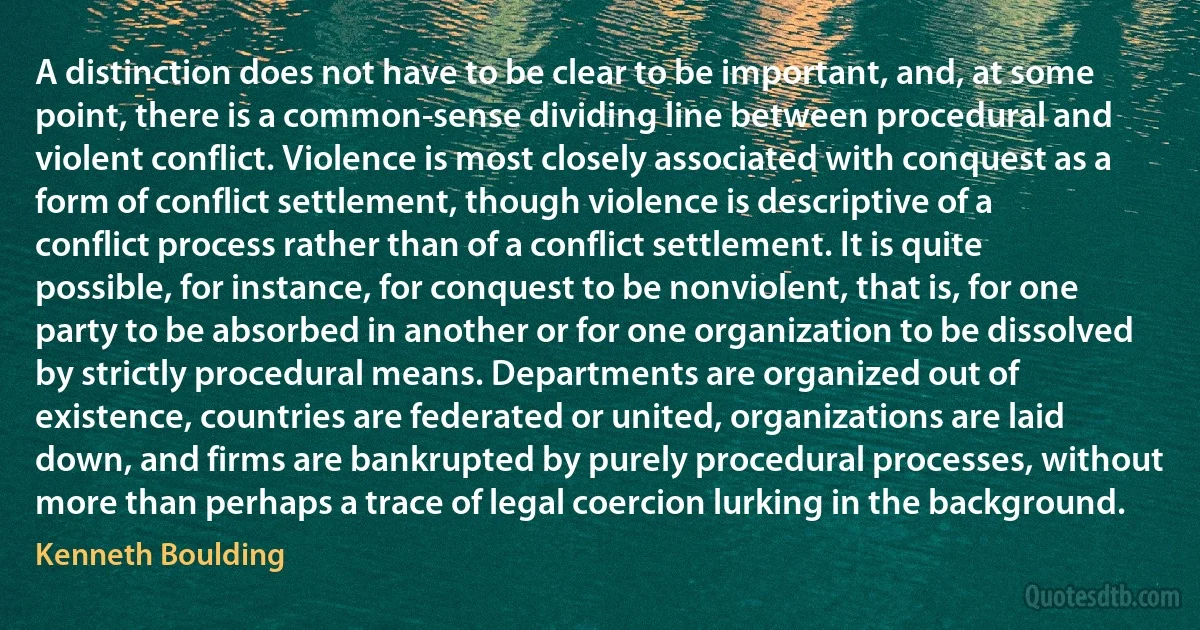
A distinction does not have to be clear to be important, and, at some point, there is a common-sense dividing line between procedural and violent conflict. Violence is most closely associated with conquest as a form of conflict settlement, though violence is descriptive of a conflict process rather than of a conflict settlement. It is quite possible, for instance, for conquest to be nonviolent, that is, for one party to be absorbed in another or for one organization to be dissolved by strictly procedural means. Departments are organized out of existence, countries are federated or united, organizations are laid down, and firms are bankrupted by purely procedural processes, without more than perhaps a trace of legal coercion lurking in the background.
Kenneth BouldingRelated topics
clear coercion conquest descriptive form instance lay line organization party perhaps point possible quite means proceduralRelated quotes
A pure Democracy, by which I mean a Society consisting of a small number of citizens, who assemble and administer the Government in person, can admit of no cure for the mischiefs of faction. A common passion or interest will, in almost every case, be felt by a majority of the whole; a communication and concert result from the form of Government itself; and there is nothing to check the inducements to sacrifice the weaker party, or an obnoxious individual. Hence it is, that such Democracies have ever been spectacles of turbulence and contention; have ever been found incompatible with personal security, or the rights of property; and have in general been as short in their lives, as they have been violent in their deaths.

James Madison
Surely, the violence and the entity who says, "I must change violence into non-violence", are both the same. To recognize that fact is to put an end to all conflict, is it not? There is no longer the conflict of trying to change, because I see that the very movement of the mind not to be violent is itself the outcome of violence.
So, the questioner wants to know why it is that he cannot go beyond all these superficial wrangles of the mind. For the simple reason that, consciously or unconsciously, the mind is always seeking something, and that very search brings violence, competition, the sense of utter dissatisfaction. It is only when the mind is completely still that there is a possibility of touching the deep waters.

Jiddu Krishnamurti
Parts of the Muslim Brotherhood have a highly ambiguous relationship with violent extremism. Both as an ideology and as a network it has been a rite of passage for some individuals and groups who have gone on to engage in violence and terrorism. It has stated its opposition to al-Qaida (AQ) but it has never credibly denounced the use made by terrorist organisations of the work of Sayyid Qutb, one of the Brotherhood's most prominent ideologues. Individuals closely associated with the Muslim Brotherhood in the UK have supported suicide bombing and other attacks in Israel by Hamas, an organisation whose military wing has been proscribed in the UK since 2001 as a terrorist organisation, and which describes itself as the Palestinian chapter of the Muslim Brotherhood.

David Cameron
Why can stars do better than the big bang? ...During the big bang, there were only a few minutes when nuclei could form. Very rare processes, or slow ones, played little role. A case in point is the key process from which the sun derives its energy. In this reaction, two protons collide to produce a deuterium nucleus, a neutrino, and a positron. ...This reaction belongs to the family of weak interactions. ...It remains... a remarkable-and for humanity, remarkably fortunate-circumstance that the central reaction that drives the sun is so rare. It is only this extraordinary rarity that allows the average proton in the sun to last so long, billions of years, even though it is colliding with other protons millions of times a second. ...an entertaining example of Treiman's theorem.

Frank Wilczek
In Hawaii the United States has another possible source of undesirable immigration. The dominant element among its third of a million inhabitants is the Japanese, who have held themselves aloof from the other residents and shown little tendency to intermarry. Every Japanese child born in the islands is an American citizen, with the full right of entry to the mainland. The greater part of the rest of the population is a mongrel crowd. Chinese and native Hawaiians, until quite recently, have shown a marked tendency to intermarry. Every effort should be made to find some constitutional way by which Hawaii can be prevented from becoming a continuous source of supply of undesirable citizens of the United States.

Madison Grant
